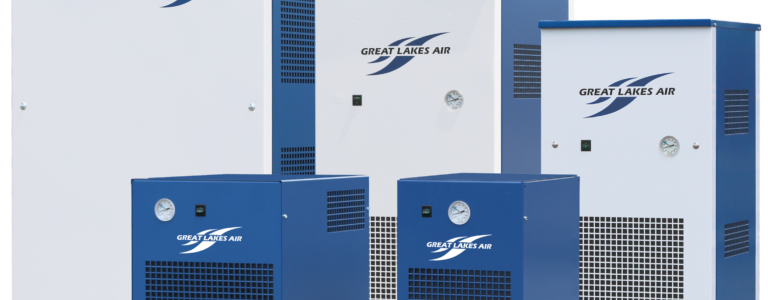Compressed air is a critical utility in many industrial processes, powering machinery, tools, and equipment across various sectors. However, when air is compressed, it naturally generates moisture, which can lead to significant issues if not properly managed. This is where industrial compressed air dryers come into play. These devices are essential for ensuring that the compressed air system operates efficiently and reliably. In this guide, we will explore how industrial compressed air dryers work, why they are important, and the different types available.
The Role of Industrial Compressed Air Dryers
An industrial compressed air dryer’s primary function is to remove moisture from the compressed air before it reaches the equipment or product. During the compression process, air is forced into a smaller volume, which raises its temperature and increases its moisture-holding capacity. As the air cools, the moisture condenses, potentially leading to corrosion, damage to equipment, blockages in the system, and contamination of the end product.
Compressed air dryers prevent these problems by removing water vapor, ensuring that the air used in industrial processes is clean and dry. This is crucial in industries such as manufacturing, pharmaceuticals, food and beverage, electronics, and automotive, where moisture in the compressed air can compromise product quality and damage sensitive machinery.
Moisture in compressed air systems can lead to various issues, including:
1. Corrosion: Moisture causes rust and corrosion in pipelines, valves, and other components, reducing their lifespan and leading to costly repairs and maintenance.
2. Equipment Failure: Excess moisture can damage air-powered tools, pneumatic controls, and machinery, leading to frequent breakdowns and inefficiencies.
3. Product Quality Issues: In industries like food processing, pharmaceuticals, and electronics, even the smallest amount of moisture can ruin a batch of products, resulting in waste and financial loss.
4. System Blockages: Moisture can freeze in cold conditions, leading to blockages in the compressed air lines and interruptions in production.
An industrial compressed air dryer eliminates these risks by removing moisture, ensuring a smooth and reliable operation of air-powered equipment and processes.
Types of Industrial Compressed Air Dryers
There are several types of industrial compressed air dryers, each designed to meet specific needs based on the environment, required air quality, and operating conditions. The most common types include:
1. Refrigerated Air Dryers
– How They Work: Refrigerated air dryers use a cooling process to lower the air temperature, causing moisture to condense into a liquid that can then be drained away.
– Applications: These dryers are ideal for general-purpose applications where the air does not need to be extremely dry. They are commonly used in automotive, manufacturing, and food and beverage industries.
– Advantages: They are relatively low-cost, energy-efficient, and require minimal maintenance.
2. Desiccant Air Dryers
– How They Work: Desiccant air dryers use a drying agent, known as desiccant material, that adsorbs moisture from the compressed air. This type of dryer typically involves a twin-tower setup where one tower dries the air while the other regenerates the desiccant.
– Applications: Desiccant dryers are used when a very low dew point is required, such as in pharmaceutical manufacturing, electronics, and chemical processing.
– Advantages: They are highly effective in producing ultra-dry air, even in extremely cold environments.
3. Membrane Air Dryers
– How They Work: Membrane air dryers use specialized membrane fibers to separate water vapor from the compressed air. The dry air passes through while the moisture is vented out.
– Applications: These dryers are suited for small-scale operations or applications requiring lower airflow rates, like laboratories or medical equipment.
– Advantages: They have no moving parts, making them silent, maintenance-free, and ideal for sensitive applications.
4. Deliquescent Air Dryers
– How They Work: Deliquescent dryers use a chemical that absorbs moisture from the air and dissolves into a liquid. This process removes the water vapor as the air passes through the chemical bed.
– Applications: Typically used in remote or outdoor installations such as oil and gas pipelines, where power sources are limited.
– Advantages: They are simple, reliable, and require no electricity, making them highly suitable for rugged environments.
Key Benefits of Using Compressed Air Dryers
1. Increased Equipment Lifespan: By removing moisture, compressed air dryers help prevent corrosion and wear in tools and equipment, extending their operational life.
2. Improved Efficiency: Dry air ensures that machinery and pneumatic systems operate smoothly, reducing downtime and increasing productivity.
3. Cost Savings: Preventing damage to equipment and reducing product waste translates to significant savings in maintenance and production costs.
4. Enhanced Product Quality: Consistently dry air helps maintain the integrity of products, which is crucial in industries where precision and quality are essential.
Choosing the Right Compressed Air Dryer
Selecting the right compressed air dryer depends on several factors, including the required dew point, operating conditions, airflow rate, and specific industry standards. It’s important to consider the level of dryness needed, the environment in which the dryer will operate, and the cost implications of each type of dryer.
Industrial compressed air dryers are essential for maintaining the efficiency and longevity of compressed air systems in a variety of industries. By eliminating moisture from the air, these dryers protect equipment, improve product quality, and reduce maintenance costs. Understanding the different types of air dryers and their specific applications can help businesses choose the best solution for their needs, ensuring a reliable and efficient operation.

